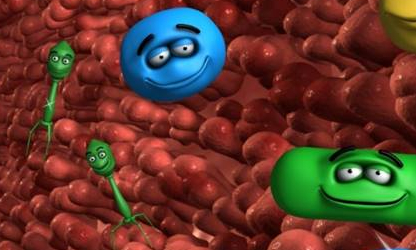

Science Service, Inc.
Viruses That Slay Bacteria Draw New Interest
Travis, J. - Science News June 3, 2000
For people with a damaged liver or too much iron in their blood, enjoying raw oysters from the Gulf of Mexico is a deadly gamble. Most of the oysters harbor Vibrio vulnificus, a bacterium responsible for almost all seafood-related deaths in the United States. Healthy people shrug off the microbe, but susceptible folks who get a full-blown infection have more than a 50 percent chance of dying. "You can be dead within 24 hours," says Paul A. Gulig of the University of Florida College of Medicine in Gainesville. Seeking a treatment that works faster than antibiotics do, he and his colleagues recently isolated a bacteria-killing virus, or bacteriophage, that targets V. vulnificus and can prevent the deaths of mice infected with it.
Gulig's report was one of a handful on bacteriophage therapy presented last week at the American Society for Microbiology (ASM) meeting in Los Angeles. Other scientists described phages that attack bacteria that cause anthrax, wound and burn infections, and meat and poultry contamination.
Although U.S. physicians today don't embrace the strategy, phage therapy dates back almost a century (SN: 6/1/96, p. 350). The viruses infect, reproduce within, and eventually burst bacteria. Since phages reproduce only as long as they have target bacteria to infect, Elizabeth M. Kutter of Evergreen State College in Olympia, Wash., calls the viruses "self-replicating, self-limiting antibiotics."
In the V. vulnificus work, Gulig and his colleagues sampled muck from oyster beds and isolated phages that destroy the bacterium. They simultaneously infected mice with V. vulnificus and enriched the rodents' blood with iron, which helps the bacterium thrive. When given phages at the time of infection, five of eight mice remained healthy. Without such treatment, all mice succumbed within 18 hours.
Gulig cautions that his team has just begun to examine phage therapy for V. vulnificus. The scientists plan to test a cocktail of phages and to find out whether phages can help rodents when treatment comes a few hours after infection.
Like Gulig, Michael H. Walter of the University of Northern Iowa in Cedar Falls has turned to phages to defeat a deadly bacterium. His enemy is Bacillus anthracis, the germ responsible for anthrax.
Since the anthrax bacterium is dangerous to handle, Walter's group has begun characterizing phages that infect a harmless relative, Bacillus cereus. Such viruses may prove useful in anthrax therapy, says Walter, or in destroying stockpiles of B. anthracis captured from terrorists or rogue countries.
As bacteria increasingly develop antibiotic resistance, several U.S. companies have also taken an interest in phage therapy. One, the Baltimore firm Intralytix, works closely with the Eliava Institute of Bacteriophage, Microbiology, and Virology in Tbilisi, Georgia, which has developed phages for medical use since 1934. Physicians in the former Soviet Union regularly turn to phages.
At the ASM meeting, Intralytix cofounder and Georgian scientist Alexander Sulakvelidze described his firm's progress in identifying phages that destroy the Salmonella bacteria that commonly infect meat, poultry, and eggs. One phage alone kills 90 percent of common Salmonella strains, and a cocktail of phages eliminates 95 percent, he says.
Intralytix scientists bought chicken in groceries and seeded it with Salmonella. Spraying the poultry with phages dramatically reduced contamination, the researchers report. Sulakvelidze predicts that the poultry industry will begin testing this disinfection strategy in their processing plants within a year.
Moreover, Intralytix plans to bring to market a U.S. version of a bacteriophage-impregnated, biodegradable polymer originally created by Georgian scientists. Intended to prevent infections in burns and wounds, the skinlike dressing has passed clinical testing in Georgia. Kutter calls it "the most exciting new phage-therapy product in recent years."
Intralytix and several other firms are also studying whether phages can help people infected with strains of Enterococcus and Staphylococcus that are resistant to all antibiotics, including vancomycin, currently the drug of last resort. "There's nothing else we can use to treat these patients," says Sulakvelidze.
COPYRIGHT 2000 Science Service, Inc.





